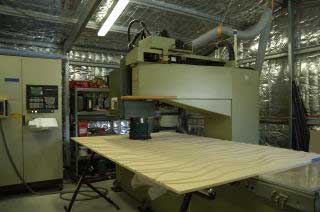Finishing Dimpled MDF
A three-dimensional dimpled pattern made on a CNC in MDF needs a metallic finish. It's not going to be easy.
Question
I am not a finisher. I know just enough about finishing to make a nice project look bad. I am a CNC programmer and I have programmed a 2" ballend bit to cut rows of dimples in a sheet of high density MDF board. It resembles an egg crate when it's done. Being high density, it mills very smooth. But as soon as sanding sealer is applied, it raises the grain in these cups. It gets an automotive like metallic paint for a finish. It looks like we'll have to sand each cup… unless there is a sealer that will not raise the grain. And advice?
Forum Responses
(Finishing Forum)
From contributor R:
What kind of sanding sealer are you using? Solvent-based? Waterborne?
From contributor M:
It is hard to raise the grain if you are using MDF. Wood has grain that will raise, MDF has cellulose particles that are glued together. If you soaked the stuff in water you will fill the remaining cellular structure and get expansion. Most sanding sealers have very little resin content, so you will get more telegraphing of the rough cut particles than expansion of the particles. You can use an automotive polyester spray body fill or, my favorite, make a wash of either hide or carpenter glue with warm water. This can be poured, brushed or sponged of. Once dry, sand with 120, then start sealing.
From contributor L:
You are going to have to sand the sealer before you topcoat it anyway. Otherwise you will have adhesion problems. What kind of sealer are you using - waterborne or solvent? WB will raise the grain much more than solvent.
From contributor A:
We use an ML Campbell primer called Clawlock. We find it fills well and is easy to sand. Spray a couple of coats. They should be a solid white colour. Sand with 320, spray a coat that flows out nicely (no sags). Sand with 5 or 600, try not to burn through. Depending on the topcoat, you can spray it now or give it a coat of Clawlock to fill the sanding scratches.
From contributor D:
I hope for your sake you don't have to finish multiple panels. You have a labor intensive and challenging job for a skilled finisher, let alone a newbie. For starters, expect problems getting a wet coat into the bottoms of the cups. You'll need to lower your air pressure a lot, and narrow your spray pattern so you're not just filling them with dry spray. A small amount of retarder would be a good idea.
You will have to sand these routed surfaces, no avoiding this, especially with a metallic finish. Maybe you can round over the end of a 1" dowel to conform to the surface and use the thin sanding sponges to ease the tedium of hand sanding the egg crates one by one? I'd try to closely match my primer color to the metallic finish coat. If you sand through the primer, a second coat is needed. Sand with 280 or 320 without cutting through the color and blow the sanding dust out of the cups (and off of yourself). Spraying metallics takes practice, even on flat surfaces, so this job will be a challenge. Make a panel, perfect your technique, and have fun on this one.
I would advise you to have the client sign off on a sample.
